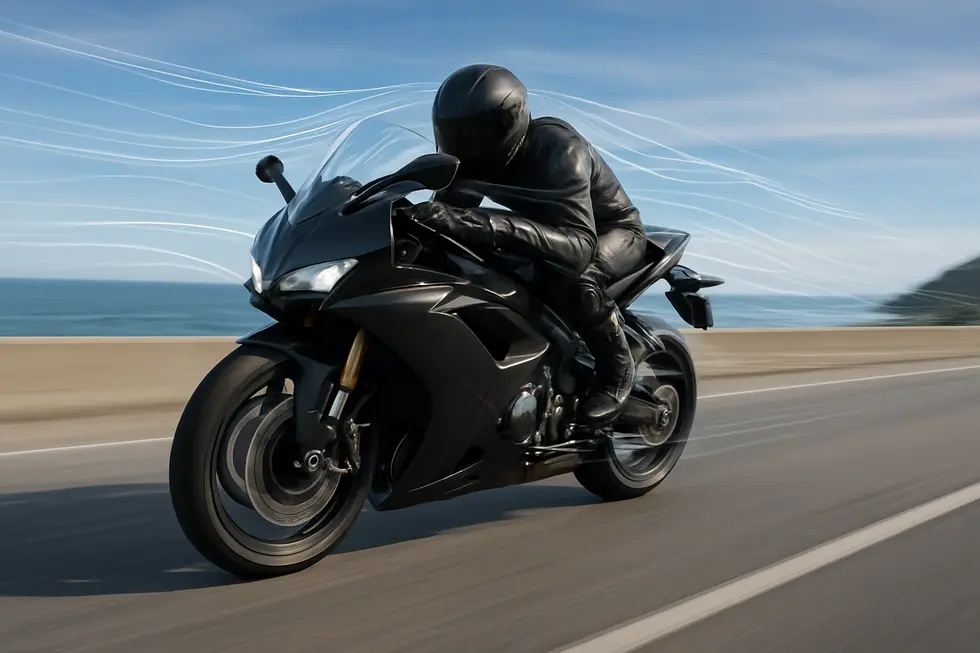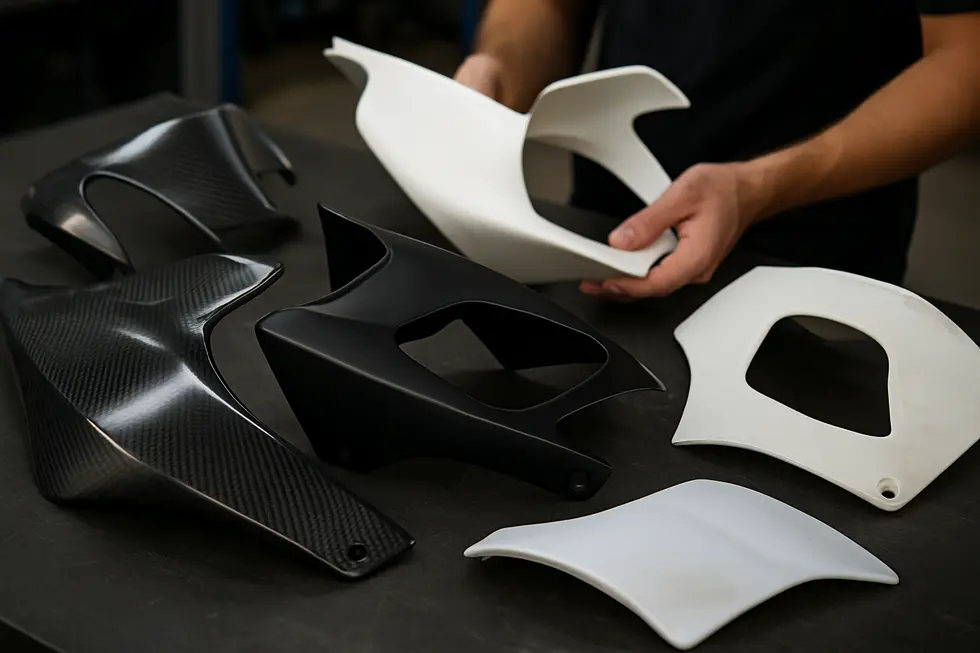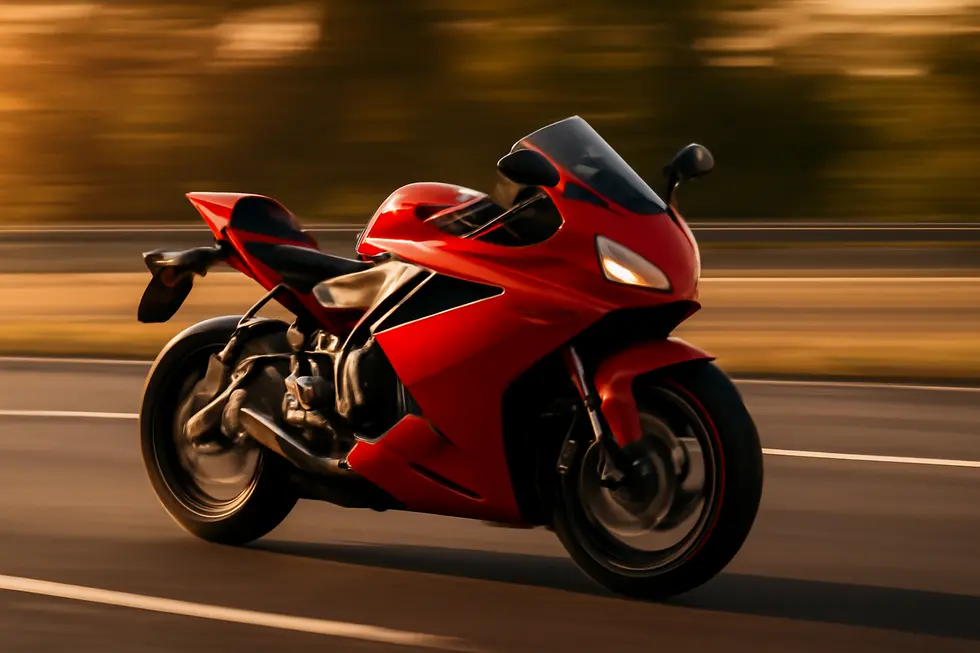Maximizing Business Potential with Motorcycle Fairings: Functional, Custom, and Innovative Solutions
August 16, 2025 | by summitfairings

Introduction
Motorcycle fairings are more than just aesthetic enhancements; they are integral components that influence a bike’s performance, safety, and marketability. For business owners in the motorcycle industry, understanding the multifaceted benefits and varieties of fairings is crucial to meeting customer demands and staying competitive. This comprehensive exploration delves into the core functional and aerodynamic advantages fairings provide, examines customization and brand-specific options that cater to diverse rider preferences, and highlights the latest materials and technological innovations reshaping the market. Together, these perspectives equip businesses with the knowledge to offer superior products and align with evolving rider expectations.
Tables of Contents
Chapter 1: Optimizing Motorcycle Performance Through Functional and Aerodynamic Fairings
- Mastering Aerodynamics in Motorcycle Fairings: How Design Reduces Drag and Boosts Speed
- Integrated Safety and Rider Shielding: How Fairings Defend Against Wind and Debris
- Enhancing Stability and Handling: How Motorcycle Fairings Combat Crosswinds and Generate Downforce
- Maximizing Fuel Efficiency and Cost Savings through Aerodynamic Motorcycle Fairings
- Enhancing Rider Comfort and Reducing Fatigue: Aerodynamic and Ergonomic Roles of Motorcycle Fairings
Chapter 2: Customization and Brand-Specific Motorcycle Fairing Options
- Advances in Lightweight Materials and Precision Manufacturing for Tailored Motorcycle Fairings
- Optimizing Performance with Tailored Motorcycle Fairings: Material, Fit, and Aerodynamic Advantages
- Precision Fit and Distinctive Style: Tailored Fairing Solutions for Leading Motorcycle Brands
- Seamless Fusion of Style and Function: Integrating Accessories in Brand-Focused Fairing Customization
- Evolving Market Dynamics and Rider Preferences in Brand-Focused Fairing Customization
Chapter 3: Materials and Technological Innovations Shaping Modern Motorcycle Fairings
- Revolutionizing Motorcycle Fairings with Carbon Fiber Composites and Lightweight Alternatives
- Cutting-Edge Materials and Aerodynamic Technologies Transforming Motorcycle Fairing Performance
- Advanced Materials and Customization Techniques Shaping Motorcycle Fairing Design
- Economic and Manufacturing Impact of Advanced Materials and Technology in Motorcycle Fairings
- Advancing Sustainability: Eco-Friendly Materials and Innovations Shaping Modern Motorcycle Fairings
Chapter 1: Optimizing Motorcycle Performance Through Functional and Aerodynamic Fairings

1. Mastering Aerodynamics in Motorcycle Fairings: How Design Reduces Drag and Boosts Speed
Mastering Aerodynamics in Motorcycle Fairings: How Design Reduces Drag and Boosts Speed
The aerodynamic design of motorcycle fairings plays a pivotal role in improving overall performance by significantly reducing air resistance and enhancing stability. By enveloping most of the front and sides of the motorcycle, full fairings streamline airflow around both the bike and rider, effectively minimizing wind turbulence that otherwise increases drag. This smooth airflow reduction directly allows motorcycles to reach higher speeds with less power from the engine, resulting in better acceleration and fuel efficiency.
Beyond merely cutting drag, aerodynamic fairings can generate downforce, which pushes the motorcycle onto the road surface. This increased traction is essential for maintaining control during fast accelerations and aggressive cornering, thereby improving handling and rider confidence. The strategic shaping of front cowling and side panels achieves these forces subtly without causing destabilizing air currents.
Material innovation further enhances these aerodynamic advantages. Carbon fiber composites, known for their lightweight strength, permit the crafting of intricate, sleek fairing shapes with extremely smooth surfaces. These attributes reduce weight and turbulence simultaneously, enabling up to a 20% drop in drag compared to traditional metal or plastic fairings. Less weight also means the engine expends less effort, contributing to improved fuel economy and quicker throttle response.
Advanced racing motorcycles incorporate aerodynamic elements such as winglets and minimized air ducts that provide additional downforce and cooling without significantly increasing drag. Such design refinements maintain top speed and offer crucial stability at extreme velocities, illustrating how precise aerodynamic tuning lifts both performance and safety.
For riders looking to unlock the full potential of their motorcycles, understanding and selecting aerodynamic fairings is key. These enhancements not only elevate speed but also improve fuel efficiency and handling, blending form with function in ways that benefit all riders. More details on performance-focused fairing options can be explored through discover affordable motorcycle fairings.
For additional insight into advanced aerodynamic designs, refer to the Suzuki GSX-R1000R Aerodynamic Features.
2. Integrated Safety and Rider Shielding: How Fairings Defend Against Wind and Debris
Motorcycle fairings play a crucial role in enhancing rider safety by combining aerodynamic efficiency with effective protection against wind and debris. Designed to manage airflow around the bike, fairings reduce drag and stabilize the ride, but their benefits extend well beyond speed. By shielding the rider’s torso and head from direct windblast, fairings minimize physical fatigue, allowing for longer, more comfortable journeys without compromising visibility. This barrier also deflects airborne debris such as stones, insects, and road spray, which can otherwise cause injury or distraction, significantly raising rider safety.
Moreover, fairings safeguard essential motorcycle components from environmental hazards including rain, dust, and minor impacts, preserving mechanical integrity and consistent performance. Advanced fairing designs incorporate winglets that not only bolster aerodynamics but help maintain tire grip by generating subtle downforce, indirectly enhancing rider control and safety during cornering and high-speed riding. However, the efficacy of these protective functions depends heavily on the fairing’s condition. Regular maintenance ensures that cracks or loose mounts do not impair aerodynamic performance or create instability that may compromise rider security.
This balance of aerodynamic refinement and protective shielding creates a safer riding environment by reducing wind fatigue and environmental exposure, while helping maintain the bike’s integrity. Riders benefit from a design that thoughtfully integrates comfort and defense, contributing to safer and more enjoyable rides. For those interested in customizing or upgrading for optimal protection and style, there is a wealth of options available across many motorcycle brands.
Learn more about choosing from a variety of fairings to enhance both safety and aesthetics in Discover Affordable Motorcycle Fairings at Summit Fairings.
For further insights into the aerodynamic impact of motorcycle fairings, see this detailed exploration of Aerodynamics of Motorcycle Fairings.
3. Enhancing Stability and Handling: How Motorcycle Fairings Combat Crosswinds and Generate Downforce
Motorcycle fairings are pivotal in refining the vehicle’s stability and handling by expertly managing aerodynamic forces such as crosswinds and downforce. By streamlining airflow, fairings reduce drag and turbulence, which otherwise cause lift that can destabilize the motorcycle at high speeds. This streamlined design helps maintain consistent tire-road contact, which is essential for rider control and safety.
Modern fairings often incorporate aerodynamic features like winglets and spoilers that generate downforce—an essential force pressing the motorcycle closer to the road. This increased downforce improves traction, allowing riders to corner with enhanced confidence and control even during aggressive maneuvers. These design elements support higher speed stability and contribute to better wheel-road grip, which is crucial in both racing and everyday riding conditions.
Crosswinds pose a significant challenge by exerting lateral forces that can push the motorcycle off its intended path. Well-crafted fairings are carefully shaped to minimize these side forces, deflecting wind away from the rider and motorcycle frame. By reducing turbulence especially around the front wheel and rider, these designs also contribute to steadier handling. Additionally, aerodynamic screens and wind deflectors are optimized to lessen buffeting and wind pressure, directly reducing rider fatigue and enhancing comfort when riding in variable wind conditions.
Advancements in aerodynamics have led manufacturers to integrate comprehensive packages that synergize fairing shape and chassis tweaks, further improving downforce and crosswind resilience. These improvements enable riders to maintain better control, stability, and confidence at high speeds and through challenging corners without compromising comfort.
Overall, motorcycle fairings play a crucial role not only in decreasing drag and enhancing aesthetics but also in elevating dynamic performance by stabilizing the bike against winds and optimizing traction. This holistic aerodynamic approach significantly improves both safety and rider experience.
For enthusiasts interested in exploring a wide range of customizable and performance-oriented motorcycle fairings, a comprehensive selection can be found at Summit Fairings.
Reference: Aerodynamic design concepts enhancing downforce and reducing drag for motorcycles.
4. Maximizing Fuel Efficiency and Cost Savings through Aerodynamic Motorcycle Fairings
Motorcycle fairings play a pivotal role in enhancing fuel efficiency by streamlining airflow and minimizing drag forces that directly impact engine workload. By allowing air to glide smoothly over the motorcycle’s surface, fairings reduce turbulence and wind resistance, particularly at high speeds where aerodynamic drag is most pronounced. This efficient airflow means the engine expends less energy to maintain velocity, translating to lower fuel consumption and an extended riding range.
Full fairings deliver the greatest aerodynamic advantage by enveloping the bike more comprehensively than partial fairings. They produce beneficial downforce, improving tire grip and stability without sacrificing fuel economy. Advanced aerodynamic features—such as precisely contoured winglets seen in leading models—counter front-end lift, enhancing control and safety while further reducing air resistance. These improvements collectively lead to a more economical ride, where fuel savings can accumulate significantly over time.
From an economic standpoint, investing in quality fairings also helps protect engine components and critical systems from debris and weather damage. This protection reduces wear and maintenance costs, preserving both performance and appearance. However, regular inspection is vital, as deteriorated or damaged fairings can compromise aerodynamic benefits and rider safety. Common indicators like cracks or loose fittings should prompt timely replacement to sustain efficiency and structural integrity.
In effect, well-designed motorcycle fairings are an investment not only in performance and style but also in the practical economy of riding. Riders seeking to optimize fuel efficiency and lower operational costs will find that aerodynamic enhancements directly contribute to these goals, balancing performance with long-term value. For further insights into the influence of aerodynamics on fuel consumption, explore the detailed explanation in this external resource.
For a wide selection of motorcycle fairings that combine functional aerodynamic benefits with customization options, visit Summit Fairings blog.
5. Enhancing Rider Comfort and Reducing Fatigue: Aerodynamic and Ergonomic Roles of Motorcycle Fairings
Motorcycle fairings play a crucial role in enhancing rider comfort and minimizing fatigue, especially during long-distance journeys. By creating a streamlined shield, fairings reduce exposure to turbulent airflow, forming a “bubble of calm air” around the rider’s body. This aerodynamic refinement lessens wind pressure on critical areas like the hands and shoulders, which significantly lowers physical strain caused by constant buffeting and vibrations. The result is a marked reduction in wind fatigue, allowing riders to maintain focus and comfort for extended periods.
Fairings also improve stability by mitigating the effects of crosswinds, providing safer, more controlled handling on highways and open roads. This built-in wind protection supports smoother rides in varying conditions, decreasing the rider’s need to fight against unpredictable gusts. The design of fairings complements these aerodynamic benefits with ergonomic enhancements, such as repositioned footpegs that encourage a tucked, relaxed posture and reshaped seats that better secure the rider during braking and acceleration. These adjustments help distribute forces more evenly across the body, reducing muscular strain and enhancing control.
The mounting style of fairings influences comfort levels as well. Frame-mounted fairings offer superior wind deflection compared to bar-mounted designs, which means less handlebar fatigue during lengthy rides. Various aftermarket options extend these benefits by blending practical performance with aesthetic appeal—some fairings focus on increasing torso coverage without sacrificing visibility, striking a fine balance between protection and rider awareness.
Together, these aerodynamic and ergonomic features transform the riding experience, supporting both functional performance and rider endurance. For those interested in exploring how advanced motorcycle fairing designs optimize comfort alongside style, valuable insights can be found at Explore the Best Motorcycle Fairings. Further details on aerodynamic mastery can be reviewed in this in-depth resource: https://livingwithgravity.com/red-dot-if-award-winning-new-panigale-v4-ducatis-design-mastery/
Chapter 2: Customization and Brand-Specific Motorcycle Fairing Options

1. Advances in Lightweight Materials and Precision Manufacturing for Tailored Motorcycle Fairings
Motorcycle fairings have evolved significantly through innovations in materials and manufacturing techniques that prioritize performance, aesthetics, and brand identity. The rise of advanced composites like carbon fiber has transformed customization by offering a lightweight yet robust alternative to traditional fiberglass or aluminum. Carbon fiber fairings reduce weight by up to 50%, enhancing a motorcycle’s agility, acceleration, and fuel efficiency. Beyond weight savings, these composites enable the creation of streamlined, aerodynamic shapes that cut air drag by approximately 15-20%, crucial for sport and track motorcycles aiming to maximize speed and stability.
Customization extends deeper than material choice; the integration of color-matching paints and intricate patterns onto carbon fiber surfaces allows riders to express personal style while preserving durability in variable conditions. For riders seeking a cost-effective upgrade, textured faux carbon fiber vinyl kits reproduce the visual appeal of premium composites without wholesale part replacement, making customization accessible across budgets.
Brand-specific fairings benefit from cutting-edge digital design tools such as computational fluid dynamics (CFD). This technology refines the aerodynamic profile tailored to the unique frame and handling characteristics of models from various manufacturers. One notable approach blends nostalgic styling cues with optimized airflow management, enhancing wind protection and reducing buffeting for a smoother ride.
Manufacturing precision now supports bespoke elements, including custom oil coolers and reinforced structural components that align perfectly with altered fairing designs. These tailored parts demonstrate how innovation expands beyond materials into a seamless combination of form and function, supporting both rider safety and elevated aesthetics.
Together, material advancements, digital engineering, and meticulous production drive motorcycle fairing customization into a realm where individual expression meets technical excellence. For detailed options, enthusiasts can explore an expansive selection of affordable and customizable fairings tailored to various motorcycles at Summit Fairings.
More insights into aerodynamic improvements and brand-centered designs can be found in external resources, such as the development of aerodynamic frame-mounted fairings on modern cruiser motorcycles.Harley-Davidson Low Rider ST
2. Optimizing Performance with Tailored Motorcycle Fairings: Material, Fit, and Aerodynamic Advantages
Performance gains from customized and brand-specific motorcycle fairings stem largely from their ability to refine aerodynamics, reduce weight, and offer a precise fit that complements a bike’s design. These aerodynamic shells are engineered to streamline airflow, minimizing drag and improving stability at high speeds—essential benefits for both street and track conditions.
High-performance custom fairings often utilize cutting-edge materials like carbon fiber, which can be up to 40% lighter than traditional fiberglass or aluminum. This weight reduction not only enhances acceleration and handling but also increases thermal resistance and durability under demanding conditions. By reducing drag by as much as 20%, these fairings contribute to improved fuel efficiency and a smoother riding experience.
Brand-specific options further optimize performance by ensuring a seamless fit tailored to the contours of particular models, such as sportbikes or cruisers. For example, carbon fiber headlight fairings designed for specialized machines improve airflow dynamics while adding an aesthetic upgrade that matches the bike’s original appearance. This careful fit also helps maintain rider comfort and protection without compromising speed or control.
Customization extends beyond materials and shape to include color matching, graphic integration, and choice of finishes. These options allow riders to express personality without sacrificing functionality. However, maintaining the integrity of fairings is crucial since damage or wear can negatively affect aerodynamic performance and safety.
Leveraging high-quality, brand-aligned fairings ensures riders receive both enhanced performance and durability tailored to their motorcycle’s unique characteristics. For those seeking reliable options, exploring a comprehensive range of motorcycle fairings can reveal customizable solutions that combine style with function.
For more detailed options in lightweight, aerodynamic fairings, consider products like customized carbon fiber fairings that merge advanced materials with racing-inspired design principles (source: https://www.alibaba.com/product-introduction/Customized-colors-carbon-fiber-MIO-sporty_1600876489225.html).
3. Precision Fit and Distinctive Style: Tailored Fairing Solutions for Leading Motorcycle Brands
Precision Fit and Distinctive Style: Tailored Fairing Solutions for Leading Motorcycle Brands
Motorcycle fairings designed specifically for individual brands and models exemplify a sophisticated blend of craftsmanship and engineering. These brand-specific fairings emphasize exact fitment, ensuring that every curve and mounting point aligns perfectly with the bike’s original structure. This precision not only preserves the motorcycle’s integrity but also enhances durability, preventing issues caused by improper installation or incompatible parts. To achieve this level of exactness, manufacturers employ advanced fabrication techniques, such as precision injection molding with high-grade ABS plastic or sophisticated carbon fiber layups. These materials provide strength and lightness, reinforcing aerodynamics while supporting bespoke finishes.
Customization goes beyond shape and material; it extends deeply into aesthetics and functionality. Riders can choose from a variety of colors, decals, and finishes that match or elevate their bike’s identity, whether it’s a sportbike, cruiser, or touring model. Complete fairing kits tailored for specific brands come pre-drilled and ready for installation, simplifying the upgrade process while preserving the original mounting systems. Accessories integrated into these kits — including windscreens, seat cowls, and heat shields — are designed to complement the bike’s mechanical and visual flow seamlessly.
Performance-oriented riders often seek carbon fiber fairings that reduce weight and improve aerodynamics without sacrificing strength or corrosion resistance. These components frequently meet stringent automotive safety standards, catering to enthusiasts wanting to optimize speed and style in unison. Beyond fairings, brand-focused custom parts like fenders, bezels, and covers align with the unique characteristics of specific motorcycle models, enhancing both utility and design coherence.
This tailored approach to fairing customization empowers riders to personalize their motorcycles while maintaining or improving performance and reliability. For more detailed insights on availability and customization of fairings, explore the comprehensive selection at Summit Fairings.
External reference: Dirty Bird Concepts Custom Parts
4. Seamless Fusion of Style and Function: Integrating Accessories in Brand-Focused Fairing Customization
Customizing motorcycle fairings extends beyond simply enhancing appearance—it demands a sophisticated balance of aesthetic appeal and functional enhancement tailored to each brand’s unique identity. Leading manufacturers of custom fairing kits prioritize this seamless integration by engineering components that not only look striking but also meet rigorous standards of fit, durability, and performance. For instance, high-quality ABS plastic molded with precision ensures that each panel aligns perfectly with the bike’s frame, creating a finish that feels factory-original. Multiple layers of resilient paint and clear coat preserve the vibrancy and longevity of colors and graphics, while offering riders options to adopt anything from subtle brand-themed palettes to bold racing-inspired accents.
Beyond surface treatments, functional accessory integration plays a critical role. Components such as windscreens, seat cowls, and heat shields are engineered as part of the package to complement the structural design, enhancing aerodynamic properties while maintaining visual harmony. The inclusion of hardware like specialized tabs and bolt kits ensures an effortless assembly experience without compromising structural integrity. Furthermore, the addition of advanced lighting solutions—such as LED auxiliary lights integrated into batwing-style fairings—reflects a fusion of safety and style, boosting rider visibility and complementing the motorcycle’s silhouette without detracting from regulatory compliance.
Brand-specific customization reaches deeper with official accessory programs from manufacturers, which offer quick-release windshields for wind resistance control, performance-driven parts, and ergonomic seats flawlessly aligned with the motorcycle’s heritage and design principles. Aftermarket innovators contribute with inventive functional upgrades that blend convenience and aggressive styling, like streamlined cup holder covers or custom headlight bezels, extending personalization while respecting original design cues.
This comprehensive approach guarantees that every accessory—whether aesthetic or functional—is thoughtfully curated and engineered to sustain the motorcycle’s brand essence, enabling riders to forge a truly unique yet authentic expression of their machine. For an extensive range of fairing options that embrace both style and functionality, explore the premium and custom styles at Summit Fairings.
For more on integrated lighting innovations, see detailed solutions from custom lighting experts here.
5. Evolving Market Dynamics and Rider Preferences in Brand-Focused Fairing Customization
Customization in motorcycle fairings has shifted from mere functionality to a vibrant form of self-expression among riders. Market trends reflect a clear surge in demand for brand-specific and bespoke fairing options, with enthusiasts seeking parts that not only match their motorcycle’s exact make and model but also deliver enhanced style and durability. Riders today value premium materials like OEM-grade ABS plastic and carbon fiber finishes, which offer both resilience and an upscale appearance tailored to their machines.
Major manufacturers increasingly embrace this trend by supporting customizable fairing kits that open avenues for personalization—whether through color schemes, integrated logos, or stylistic tweaks. This fosters brand loyalty while meeting consumer desires for unique aesthetics intertwined with practical benefits. One-piece designs and rigorously engineered fitment solutions speak directly to riders’ demand for seamless integration and ease of installation.
The preference for high-quality, model-specific fairings also aligns with parallel growth in adjacent segments like premium motorcycle audio upgrades, where technological advancements enhance the riding experience. This reflects a broader cultural shift where riders treat their motorcycles as extensions of their identity, investing in aftermarket upgrades that blend performance and personal style.
Overall, today’s market underscores a convergence of style, quality, and function. Riders appreciate branded fairings that deliver a perfect balance—durable, well-crafted, and customizable—enabling them to elevate their motorcycle’s presence on the road. This evolving landscape confirms the importance of innovative, brand-aligned options as a core component of modern motorcycle customization.
Explore more on how customization shapes fairing choices at Discover unmatched choices in motorcycle fairings at Summit Fairings.
For detailed product examples and trends in brand-specific fairings, see the insights provided by Monster Fairings here.
Chapter 3: Materials and Technological Innovations Shaping Modern Motorcycle Fairings

1. Revolutionizing Motorcycle Fairings with Carbon Fiber Composites and Lightweight Alternatives
Motorcycle fairing materials have undergone significant transformation through advances in carbon fiber composites, which now lead the way due to their exceptional strength-to-weight ratio and thermal resistance. Carbon fiber fairings reduce overall bike weight by up to 40%, enhancing handling and acceleration, while their aerodynamic design achieves up to 20% drag reduction, directly benefiting fuel efficiency and high-speed stability. These composites withstand elevated temperatures around 250°C, making them ideal for performance-focused motorcycles that face intense engine heat and environmental stress.
In addition to raw performance gains, recent innovation has introduced greater customization options. Riders can now select from a variety of colors and intricate carbon fiber weave patterns, allowing personalized style without compromising durability. This extends to aerodynamic shaping, where advanced manufacturing techniques enable flows that further reduce drag and turbulence.
While carbon fiber remains dominant, alternatives such as ABS plastic composites serve as practical choices for half or quarter fairings. These materials balance affordability, resilience, and lightness, which benefits everyday riders seeking upgrades without premium costs. Emerging production methods, including 3D printing, facilitate custom fairings with complex geometries, enabling unique designs and potentially lowering manufacturing expenses.
Beyond motorcycles, carbon fiber composites have proven their versatility in aerospace and automotive industries. High-stress components that require lightweight and heat-resistant materials, like engine braces or reusable fairings for launch vehicles, leverage carbon fiber’s strengths. Such cross-industry validation underscores the material’s evolving role in motorcycle fairing technologies.
As innovation continues, these materials enable fairings to deliver superior aerodynamic efficiency, enhanced rider personalization, and increased durability, aligning with the high-performance demands of modern motorcycling. For more detail on customized carbon fiber fairings, explore specialized resources detailing their specifications and applications. To dive into an extensive selection of motorcycle fairings and related innovations, visit Summit Fairings’ blog.
Learn more about aerospace and automotive carbon fiber uses here: https://www.hexcel.com/
2. Cutting-Edge Materials and Aerodynamic Technologies Transforming Motorcycle Fairing Performance
Motorcycle fairings are evolving through the integration of advanced materials and aerodynamic technologies that optimize performance while enhancing rider experience. Lightweight composites, particularly carbon fiber, have become the material of choice due to their exceptional strength-to-weight ratio. This allows manufacturers to craft complex, aerodynamic shapes that reduce drag and improve handling without adding unnecessary weight. Carbon fiber’s resilience also contributes to durability and heat resistance, paralleling innovations found in aerospace applications where materials must endure extreme conditions.
Aerodynamic design advances include the incorporation of integrated winglets seamlessly molded into the fairing. These winglets generate downforce at high speeds, stabilizing the bike and reducing lift that can compromise control. Moreover, they function as airflow channels to optimize cooling by directing air through strategic outlets, maintaining engine temperature without sacrificing aerodynamic efficiency. Streamlined fairing profiles with recessed leading edges reduce the impact of side winds during quick directional changes, enhancing rider control and comfort.
Emerging technologies like 3D printing enable highly customized fairing designs tailored to individual rider preferences or specific aerodynamic requirements. This flexibility supports the creation of personalized, low-weight fairings that maintain structural integrity. Additionally, modern fairings increasingly integrate LED lighting into their aerodynamic contours, marrying functionality with style while improving visibility and safety. Such technological fusion enhances rider comfort and aesthetic appeal without detracting from airflow management.
Race motorcycles exemplify these innovations by featuring full enclosures that drastically minimize drag and enhance stability at extreme speeds, crucial for competitive performance. These advancements collectively signal a shift toward fairings that optimize speed, balance, cooling, and rider comfort through smart use of materials and aerodynamic science.
For a deeper dive into selected designs and material trends, see this comprehensive overview of carbon fiber composite innovations here. Additionally, explore the broad range of options available for custom fairings and styles at Summit Fairings.
3. Advanced Materials and Customization Techniques Shaping Motorcycle Fairing Design
The evolution of motorcycle fairings has been deeply influenced by advances in materials science and customization technology, allowing riders to combine functionality with personalized aesthetics. Modern fairings frequently utilize ABS plastic, prized for its durability, lightweight nature, and precision fit to specific motorcycle models. This material enables easy installation and offers a reliable shield against wind, debris, and minor impacts, while also serving as a versatile canvas for graphical and textural enhancements. Riders can choose from vinyl wraps featuring bold geometric patterns or subtle honeycomb textures that mimic carbon fiber, catering to diverse style preferences.
Cutting-edge carbon fiber composites push the boundaries further by providing significant weight reductions—up to 40% lighter than traditional fiberglass—without sacrificing strength. This material not only improves handling and stability due to its low weight but also offers exceptional heat resistance, suitable for components exposed to engine proximity. Carbon fiber fairings allow intricate color integration within the weave or through specialized paints, enabling highly personalized visual effects. Aerodynamically, these designs can reduce drag by as much as 20%, enhancing both speed and fuel economy.
Customization now extends beyond materials to artistic finishes that blend technical benefits with signature styling. Techniques such as hand-applied paintwork, military-inspired matte finishes, and hyper-realistic airbrushing transform fairings into mobile art. Ergonomic improvements and detailed accents like chrome trims or unique wheel designs contribute to the overall riding experience. These innovations merge form and function, illustrating how fairings have become a core element of motorcycle identity and performance.
For those seeking inspiration or customizable options, exploring comprehensive collections of durable ABS vinyl kits and carbon fiber designs provides insights into current trends blending technology and artistry. As material advancements continue to integrate with creative customization, motorcycle fairings evolve as both protective gear and expressive extensions of the rider’s personality. More details on accessible yet stylish vinyl options and carbon fiber fairings are available through trusted resources like this guide to unmatched choices in motorcycle fairings.
4. Economic and Manufacturing Impact of Advanced Materials and Technology in Motorcycle Fairings
The evolution of motorcycle fairings through advanced materials and cutting-edge technologies has reshaped manufacturing dynamics and economic strategies within the industry. The introduction of materials like prepreg carbon fiber, which offers exceptional stiffness at a fraction of steel’s weight, enables manufacturers to produce lighter, more aerodynamic fairings that enhance speed and fuel efficiency. However, the benefits come with substantial challenges. Carbon fiber demands specialized, precision-intensive manufacturing processes, rigorous quality controls — often meeting ISO 9001 standards — and higher raw material costs. This manufacturing complexity translates to elevated capital investment and operational expenses, necessitating a careful balance between cost and performance benefits.
Beyond material innovation, the seamless integration of electronics such as LED lighting and ride-enhancing digital modules significantly raises production sophistication. Such features improve rider safety and visual appeal but require advanced tooling and engineering expertise to maintain structural integrity. These developments also respond to a market increasingly valuing connectivity and performance, prompting manufacturers to continuously refine design and assembly techniques.
Economically, the motorcycle fairing market experiences steady growth, driven by consumer demand for customization, aerodynamics, and safety technologies. Yet, supply chain volatility for key inputs like carbon fiber and specialized plastics introduces cost unpredictability and potential delays. To mitigate these risks, manufacturers forge robust partnerships with suppliers and OEMs, ensuring stable procurement and enabling premium pricing justified by innovation. Moreover, customization trends create demand for manufacturing flexibility—blending mass production efficiency with the ability to offer bespoke components.
These intertwined technological advances and material choices thus shape a competitive landscape where innovation is crucial to margin preservation and brand differentiation. For riders and manufacturers alike, embracing these complexities fosters fairings that merge superior function with modern design demands.
For further exploration of motorcycle fairing options and customization, visit the Summit Fairings blog.
Additional insights on premium carbon fiber manufacturing techniques are detailed in the BMW M1000RR rear fairing case study by Ilmberger Carbon.
5. Advancing Sustainability: Eco-Friendly Materials and Innovations Shaping Modern Motorcycle Fairings
Sustainability is reshaping the materials and technologies behind motorcycle fairings, emphasizing reduced environmental impact while maintaining performance and durability. Manufacturers are increasingly turning to recycled, bio-based, and lightweight composites to achieve this balance. For instance, the integration of pre-consumer recycled plastics—scraps generated during manufacturing—has emerged as a key innovation. These recycled plastics, used on high-profile models, offer comparable strength and longevity to virgin materials, minimizing resource consumption and waste simultaneously.
Bioengineered plastics such as durable, UV-resistant alternatives replace traditional petroleum-based components in fairings and windscreens. By leveraging natural feedstocks, these bio-based materials lower carbon footprints without sacrificing quality or rider protection. Similarly, recycled aluminum is gaining traction beyond small parts, being adopted for larger motorcycle elements to reduce energy-intensive metal processing.
Further advancing eco-conscious design, some manufacturers explore natural fiber composites—like flax fibers blended with recycled carbon fiber—for lightweight, sustainable bodywork. These composites blend renewable resources and recycled components to push the limits of environmental responsibility in motorcycle construction.
Notably, electric motorcycles amplify these trends by allowing lighter, more recyclable materials such as carbon fiber and aluminum alloys to be utilized effectively, enhancing overall efficiency. This synergy between new propulsion technologies and material science supports a circular economy approach, where fairings are designed for easier recycling at end-of-life.
Collectively, these innovations reflect a growing commitment within the motorcycle industry to integrate sustainability into fairing technology, merging environmental stewardship with aerodynamic and aesthetic excellence.
For those interested in exploring diverse and quality fairing options that reflect these advances, visit Explore the Best Motorcycle Fairings at Summit Fairings.
More details on sustainable materials can be found in external publications covering bioengineered plastics and recycled composites.
Final thoughts
Motorcycle fairings embody a convergence of function, style, and innovation that businesses can leverage to distinguish themselves in the motorcycle market. Understanding their aerodynamic and protective roles, offering diverse customization aligned with strong brand identities, and embracing advances in materials and technology empower business owners to meet varied rider demands effectively. By integrating these elements, companies enhance customer satisfaction, improve product value perception, and expand their market reach. Investing in quality motorcycle fairings is a strategic move that yields lasting returns through happier customers and increased loyalty.
Ready to elevate your ride? Summit Fairings delivers premium, custom-fit fairings that blend style and durability. Whether you’re chasing speed or turning heads, we’ve got your bike covered. Don’t wait—transform your machine today. Click, customize, and ride with confidence. Your perfect fairing is just a few clicks away. Act now!
About us
We are one of the leading motorcycle fairing export sites, with over 3,000 styles across almost all motorcycle models. Buy from summitfairings.com, and pay 10-40% less than the prices on other sites. If you have any questions, we promise we will have your answer within six hours.
RELATED POSTS
View all



